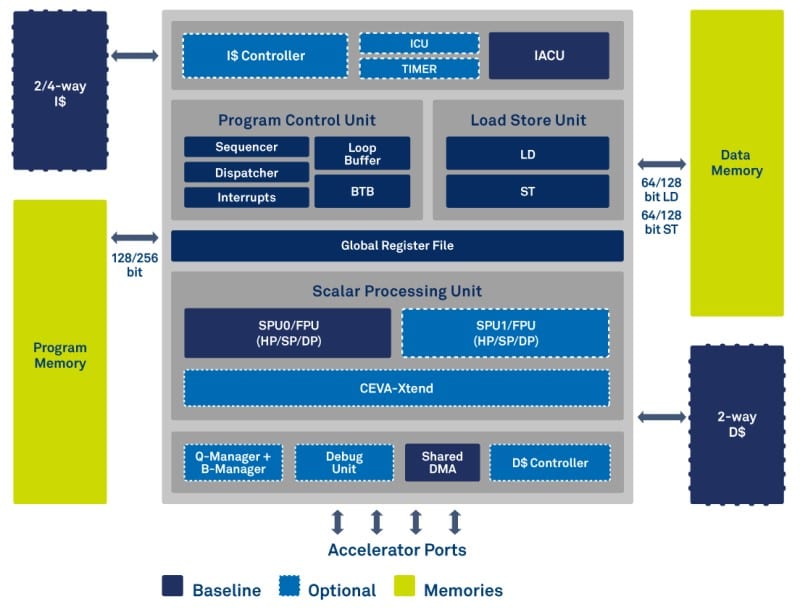Hybrid DSP / Controller for Motor Control, Consumer and IoT Devices
CEVA, Inc. announced today CEVA-BX, its new all-purpose, hybrid DSP / Controller architecture to address new algorithms of digital signal processing in voice, video, communication, sensing and digital signal control applications.
Offering general purpose DSP capabilities required for motor control and electrification, the CEVA-BX architecture extends CEVA's market reach into the burgeoning automotive and industrial markets currently underserved by legacy DSPs or MPU/MCUs with low performance DSP co-processing.
CEVA-BX offers a new breed of DSP architecture, combining the inherent low power requirements of DSP kernels with the high-level programming and compact code size requirements of a large control code base. Using an 11-stage pipeline and 5-way VLIW micro-architecture, it offers parallel processing with dual scalar compute engines, load/store and program control that reaches a speed of 2 GHz at TSMC 7nm process node using common standard cells and memory compilers.
The CEVA-BX Instruction Set Architecture (ISA) incorporates support for Single Instruction Multiple Data (SIMD) widely used in neural network inference, noise reduction and echo cancellation, as well as half, single and double precision floating point units for high accuracy sensor fusion and positioning algorithms.
 CEVA-BX block diagram (click on image to enlarge)
CEVA-BX block diagram (click on image to enlarge)
CEVA-BX employs key architecture principles of advanced micro-processor architectures such as a large orthogonal general purpose register set for maximum C compiler efficiency, innovative Branch Target Buffer (BTB) for minimizing branch overhead, hardware loop buffer for reduced power consumption of code loops, fully cached memory subsystem, and native support for all standard C types. Its CoreMark/MHz score of 4.5 reflects the superior control capabilities of the architecture.
CEVA-BX customers are able to add proprietary ISA into the architecture using the CEVA-Xtend, to accelerate proprietary algorithms and take advantage of CEVA's automatic Queue and Buffer management mechanisms to integrate co-processors and create a cluster of CEVA-BX cores.
Moshe Sheier, vice president of marketing at CEVA, commented: "The CEVA-BX architecture revolutionizes the 'all-purpose DSP' concept by offering a high-performance hybrid architecture that is a single compute island for all DSP and control workloads that are commonplace in intelligent connected devices. Using a high level programming model and parallel processing it addresses the main performance shortfalls and programming difficulties of older special purpose DSPs and controllers."
The CEVA-BX is initially offered in two configurations - the CEVA-BX1 with single 32X32-bit MAC and quad 16X16-bit MACs and the CEVA-BX2 with quad 32X32-bit MACs and octal 16X16-bit MACs, that are also capable of supporting 16x8-bit and 8x8-bit MAC operations.
The CEVA-BX2 addresses intensive workloads such as 5G PHY control, multi-microphone beamforming and neural networks for speech recognition, with up to 16 GMACs per second.
The CEVA-BX1 serves low to mid-range DSP workloads, such as cellular IoT, protocol stacks, and always-on sensor fusion, with up to 8 GMACs per second. Security is addressed using dedicated trusted execution modes to comply with the stringent safety standards.
The CEVA-BX family is accompanied by a comprehensive software development tool chain, including an advanced LLVM compiler, Eclipse based debugger, DSP and neural network compute libraries, neural network frameworks support such as Android NN API, ARM NN, and Tensorflow Lite, and choice of industry leading Real Time Operating Systems (RTOS).
Availability
The CEVA-BX architecture will be on display at CES 2019 in Las Vegas. The CEVA-BX cores are available now to lead customers and by end of Q1/2019 for general licensing.






